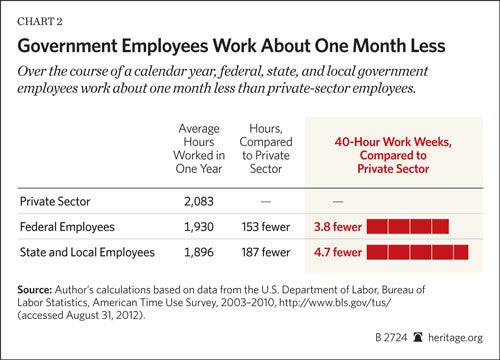Government Employees Work Less Than Private-Sector Employees
Jason Richwine /
A new Heritage Foundation study shows that government employees work around three hours less per week and roughly one month less per year than private-sector workers.
Substantial differences in work time persist even after controlling for occupational and skill differences between sectors. The “underworked” government employee should obviously be of concern to taxpayers, who expect private-sector levels of work in the public sector in exchange for private-sector levels of compensation. (continues below chart)
The Heritage study uses the American Time Use Survey (ATUS), a “time diary” dataset sponsored by the Bureau of Labor Statistics that catalogues in detail each survey respondent’s activities, including work time, during a full 24-hour period.
The ATUS has far more objectivity and precision than any other large-scale, nationally representative dataset used to estimate work time. Unlike “contract hours”—the time when employees are officially supposed to be at work—the ATUS counts all work whenever and wherever it takes place.
And unlike general survey data—which includes questions such as “How many hours do you usually work per week?”—ATUS respondents describe all of their specific activities throughout the day, leaving much less room for exaggeration of their total work time.
The Heritage study has provoked responses from public-sector advocates, some of which are collected in an article from Government Executive magazine. The individuals quoted seem to think the study used contract hours, even though not using contract hours (and using time-diary data instead) is the main contribution of the study.
Nonetheless, the article quotes government employees talking about the accuracy of their time sheets, whether they use their whole vacation allowance, how often they work from home, etc. One federal manager says, “My staff routinely works 40+ hours per week. None of this is captured in the official records because we’re only allowed to charge 40 hours per week.”
The manager is right that the official record may not accurately reflect work time, which is why the Heritage study uses actual hours of work reported in the ATUS, not official records or contract hours of any kind. The main benefit of the ATUS—made very clear in the study—is that work time is tracked for each respondent throughout the day without regard to official contract hours. The Heritage study explicitly dismisses contract hours as “insufficient” in the first “Key Point” listed on page one.
Based on the most objective comparison possible, government employees do not work as much as private-sector employees. One would hope that would-be critics would have at least a basic understanding of how the analysis was conducted before trying to dispute that fact.
Read the full report here.

